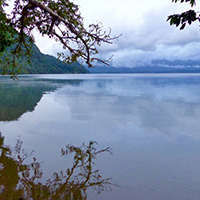Testate amoebae (Amoebozoa: Arcellinidae) as indicators of dissolved oxygen concentration and water depth in lakes of the Lacandón Forest, southern Mexico
Testate amoebae from Lacandón Forest lakes, Mexico

All claims expressed in this article are solely those of the authors and do not necessarily represent those of their affiliated organizations, or those of the publisher, the editors and the reviewers. Any product that may be evaluated in this article or claim that may be made by its manufacturer is not guaranteed or endorsed by the publisher.
Authors
The ecology of aquatic protists such as testate amoebae is poorly known worldwide, but is almost completely unknown in lakes of the northern Neotropics. To address this knowledge gap, we analyzed testate amoebae (Amoebozoa: Arcellinidae) in lakes of the Lacandón Forest, one of the most biodiverse parts of southern México. We set out to evaluate the diversity of testate amoebae communities and assess whether testate amoebae taxa are reliable indicators of environmental variables dissolved oxygen and water depth. We collected 17 surface sediment samples from a range of water depths in six lakes across the Naha-Metzabok Biosphere Reserve, northeastern Chiapas state. We identified 15 testate amoebae taxa distributed across seven genera. Eleven were identified to species level and four to strain (infra-subspecific level), and taxa were distributed unevenly among samples. Distribution of taxa in samples was related to dissolved oxygen (DO) concentration in the water measured near the sediment surface. Arcella discoides and Centropyxis aculeata strain “aculeata” were the most tolerant of low oxygen concentrations, whereas the other taxa require higher DO levels. The influence of oxygen was also seen at the assemblage level. Sites with low DO concentrations had Shannon Diversity Index (SDI) values <1.5, an indication of stressful ambient conditions. We identified two species assemblage types, which are distinguished by their oxygen concentration requirements. Assemblage 1 was more diverse and possessed species that are intolerant of low oxygen concentrations, whereas Assemblage 2 possessed fewer, rarer, opportunistic species that tolerate stressful conditions. Low oxygen concentrations are related to water depth and the combination of these two variables is important in determining the composition of testate amoebae assemblages in Lacandón Forest lakes. Quantitative relationships between testate amoebae assemblages and water depth will enable use of sedimented amoebae remains for paleolimnological inference of past water level changes in lakes of the Lacandón Forest.






